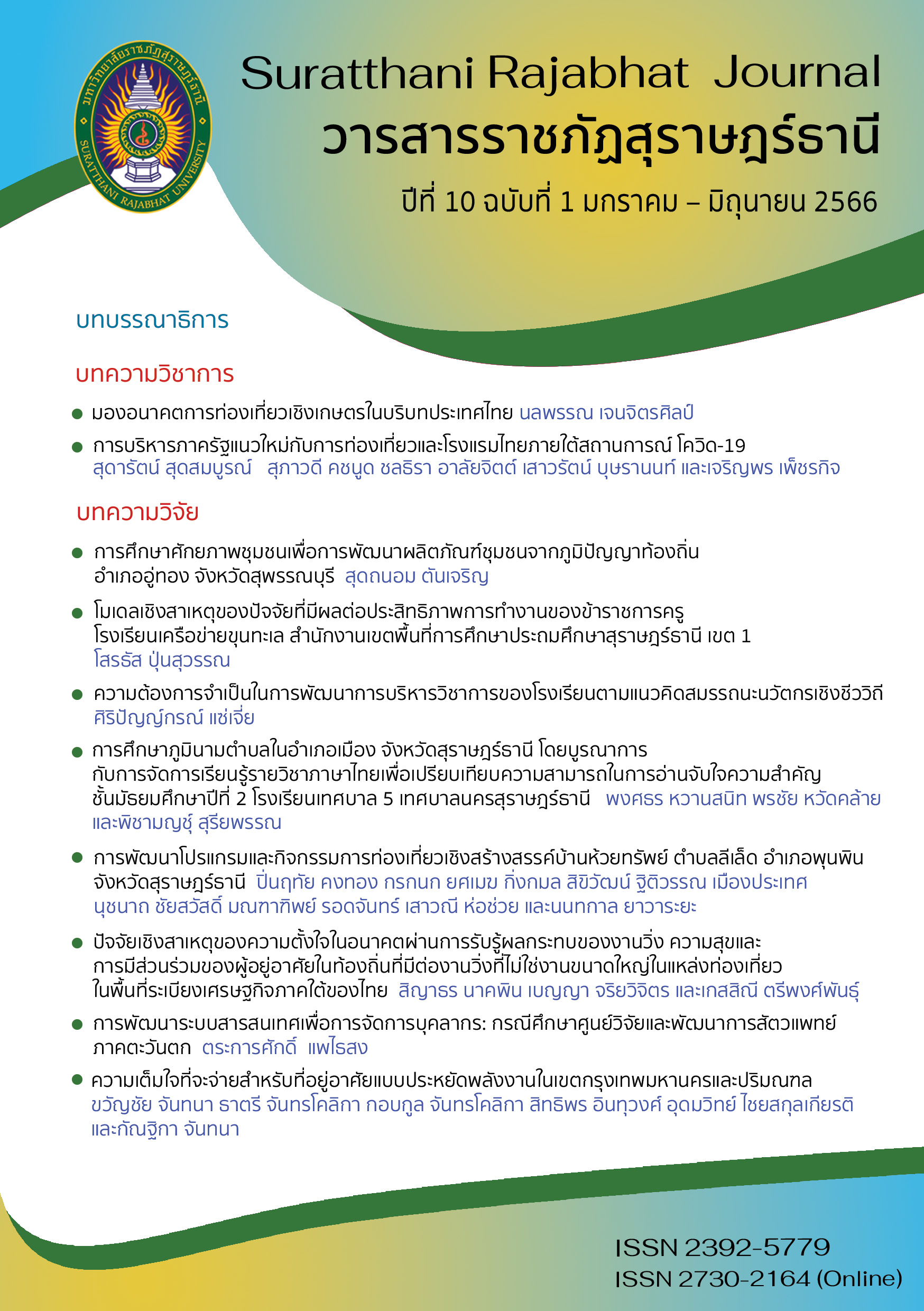The Willingness to Pay for Energy-Efficient Residence in the Bangkok Metropolitan Region
Main Article Content
Abstract
This research is quantitative research. The purpose of this research is to assess the willingness to pay for those who are interested in buying energy-saving housing in Bangkok and the metropolitan region. This is survey research and the population used in this study is those who purchased, are purchasing and considering to purchasing energy-efficient housing. A total of 409 samples were randomly selected from a stratified random sampling with Contingent Valuation Method: CV together with query Double Bounded Close-Ended. From the compilation of variables that the researcher has reached, there are four variables that were considered important variables; price, location, reputation of real estate developers and energy-efficient housing. The reliability was at 95%. The data were analyzed using the Panel Random-Effects Logit Model.
The results showed that the sample was willing to pay the following extras. For horizontal residence (Detached house) they will choose in a metropolitan region by real estate developers. Therefore, the consumers are willing to pay more from the starting price of 1.23 million baht for the add-up of the energy saving would up to 1.92 million baht. For the vertical housing (Condominium), they will choose in Bangkok developed by general real estate developers and the consumers are willing to pay more from the starting price of 0.94 million baht for more energy savings to 1.76 million baht.
The findings of this study discovered that the aspects of people's lifestyles which importantly attached to the convenience near the workplace. Correspondingly, they preferred a condominium located in Bangkok and focus on energy savings to decrease their costs of living to the aspects of privacy requirements or need space to choose a place to live.
Article Details

This work is licensed under a Creative Commons Attribution-NonCommercial-NoDerivatives 4.0 International License.
References
Anzib, N.A. (2015). The role corporate governance on financial reporting’s quality (evidence from Indonesia Stock Exchange). Research Journal of Finance and Accounting, 6(6), 128-132. https://www.researchgate.net/publication/315493668_The_Role_Corporate_Governance_on_Financial_Reporting's_Quality_Evidence_from_Indonesia_Stock_Exchange.
Aquevegue, C. & Ravasi, D. (2006). Corporate reputation, affect, and trustworthiness: an explanation for the reputation-performance relationship. Paper Presented to the Reputation Institute’s 10th International Conference on Reputation, Brand and Identity, New York, NY, June.
Cabral, M., Cheng, X., Singh, S. & Ivessa, S, A. (2016). Absence of Non-histone Protein Complexes at Natural Chromosomal Pause Sites Results in Reduced Replication Pausing in Aging Yeast Cells. Cell Rep, 17(7), 1747-1754.https://www.sciencedirect.com/science/article/pii/S221112471631470X.
Carmeli, A. & Tishler, A. (2005). Perceived organizational reputation and organizational performance: an empirical investigation of industrial enterprises. Corporate Reputation Review, 8(1), 13-30. https://doi.org/10.1057/palgrave.crr.1540236.
Khanna, C., Voordt, T. J. M. V.D. & Koppels, P. (2013). Real estate mirrors brand. Conceptual framework and practical implications. Journal of Corporate Real Estate, 15, 3-4, 213-230. https://www.researchgate.net/publication/258997599_Real_estate_mirrors_brand_Conceptual_framework_and_practical_implications.
Cochran, W.G. (1977). Sampling Techniques. 3rd Edition, John Wiley & Sons, New York.
Department of Alternative Energy Development and Efficiency, (2021). The house is comfortable.Department of Alternative Energy Development and Efficiency. Ministry of Energy. http://tene.eppo.go.th/pdf_file/C090.pdf.
Eberl, M., & Schwaiger, M. (2005). Corporate Reputation: Disentangling the Effects on Financial Performance. European Journal of Marketing, 39(7/8), 838-54. https://www.emerald.com/insight/content/doi/10.1108/03090560510601798/full/html.
Feleaga, L., Dumitrascu, M., & Feleaga, N. (2016). Corporate social responsibility and its impact on corporate governance: comparative study between listed companies on Bucharest and Bombay stock exchange. International Journal of Economics and Management Engineering, 10(11), 3758-3763. https://zenodo.org/record/1339906/files/10006296.pdf.
Fortino, G., Messina, F., Rosaci, D. & Sarne, G. M. L. (2018). Using trust and local reputation for group formation in the cloud of things. Future Generation Computer Systems, 89, 804-815. https://doi.org/10.1016/j.future.2018.07.021.
Green Network. (2019). Energy saving house A new choice for people who want to have an energy-saving home. SPECIAL Scoop https://www.greennetworkthailand.com/.
Global Buyer Survey. (2021). How are buyers’ priorities, motivations and attitudes changing?. https://content.knightfrank.com/research/2039/documents/en/global-buyer-survey-2021-8382.pdf.
Houcine, A. (2017). The effect of financial reporting quality on corporate investment efficiency: evidence from the Tunisian Stock Market. Research in International Business and Finance, 42, 321-337. https://doi.org/10.1016/j.ribaf.2017.07.066.
Kiabel, B.D., & Oyadonghan, K.J. (2015). Measuring corporate image and profitability form the perspective of comprehensive income and social cost reporting. International Journal of Economics, Commerce and Management, 3(3), 1-14. https://ijecm.co.uk/wp-content/uploads/2015/03/3322.pdf.
Kittisarn, N. (2014). Reviews of urban spatial structure: Part II a variety of literarily presented centers of Bangkok. Journal of the Faculty of Architecture King Mongkut's Institute of Technology Ladkrabang). Journal of The Faculty of Architecture King Mongkut's Institute of Technology Ladkrabang, 19(2), 173-186. https://so04.tci-thaijo.org/index.php/archkmitl/article/view/30328/26144.
Kotler, P. and Keller, L.K. (2016). Marketing Management. (14th Ed.). Upper Saddle River, N.J., Pearson Prentice Hall.
Monroe, K.B. (2003). Pricing: making profitable decisions. (3nd Ed.). New York: McGrawHill.
Nagle, T.T., Holden, R.K. and Zale, J. (2011). The strategy and tactics of pricing: a guide to profitable decision making. (5th Ed.). Pearson education, New Jersey: Prentice Hill.
Panjamaphon, A. & Chantuk, T. (2016). Factors Analysis of Demand Ecology House Estate Style. Veridian E-Journal, Silpakorn University, 9(3), 1138-1153. https://he02.tci-thaijo.org/index.phpNeridian-E-Joumal/article/download/75654160926.
Paradorn, P. (2006). Microeconomics. (2nd print) Bangkok : Thammasat University Press.
Pride, W. M., Elliott, G., Waller, D., Paladino, A., and Ferrell, O. C. (2006). Marketing: core concept and applications. (1st Ed.). Singapore: Kyodo Printing Co (S’pore) Pte Ltd.
Pride, W.M. and Ferrell, O.C. (1997). Marketing concepts and strategies. (10th Ed.). Houghton Mifflin Co.
Property Guru. (2022). What segments does a condominium have? What kind is called a luxury condominium?. https://www.checkraka.com/condo/article/130401.
Rati, T. (2005). Willingness to pay an admission fee and to support the giant pandas conservation foundation project. Master of Economics. Chiang Mai University.
Rusady, W.P. & Prasetyo, A.B. (2018). Effect of corporate governance and disclosure of corporate social responsibility on the quality of financial statements. Journal InFestasi, 14(2), 146-153. https://www.researchgate.net/publication/334295366_Effect_of_Corporate_Governance_And_Disclosure_of_Corporate_Social_Responsibility_on_The_Quality_of_Financial_Statements.
Romanos M. C. (1978). Impacts of energy policies on housing and metropolitan development. United States.
SCB Economic Intelligence Center. (2022). Drilling through the survey results for the year 2022... According to the consumer's mind. https://www.Scbeic.com/th/detail/file/product/8292/ga4tm0alaa/EIC_Realestate _survey_report_2022.pdf.
Schindler, R.M. (2012). Pricing strategies: a marketing approach. USA: SAGE Publications, Inc.
Taylor, A.V. (2009). Brand name and price cue effects within a brand extension context. Academy of Marketing Studies Journal, 13(2), 59-75. https://www.researchgate.net/publication/286986437_Brand_name_and_price_cue_effects_within_a_brand_extension_context.


